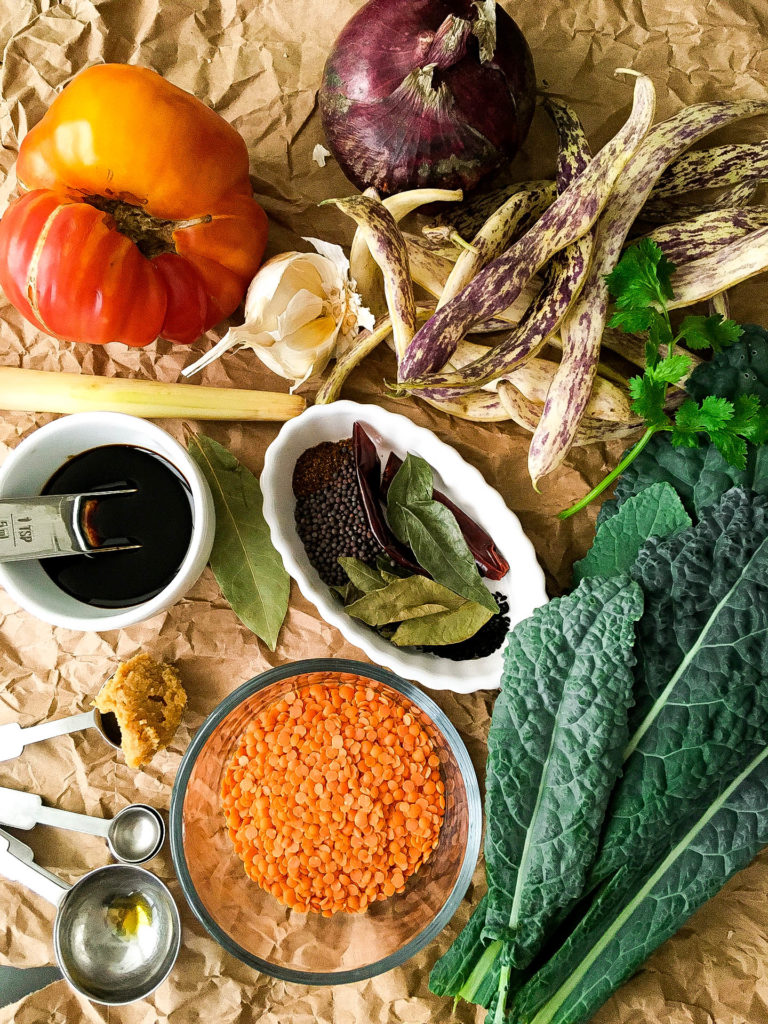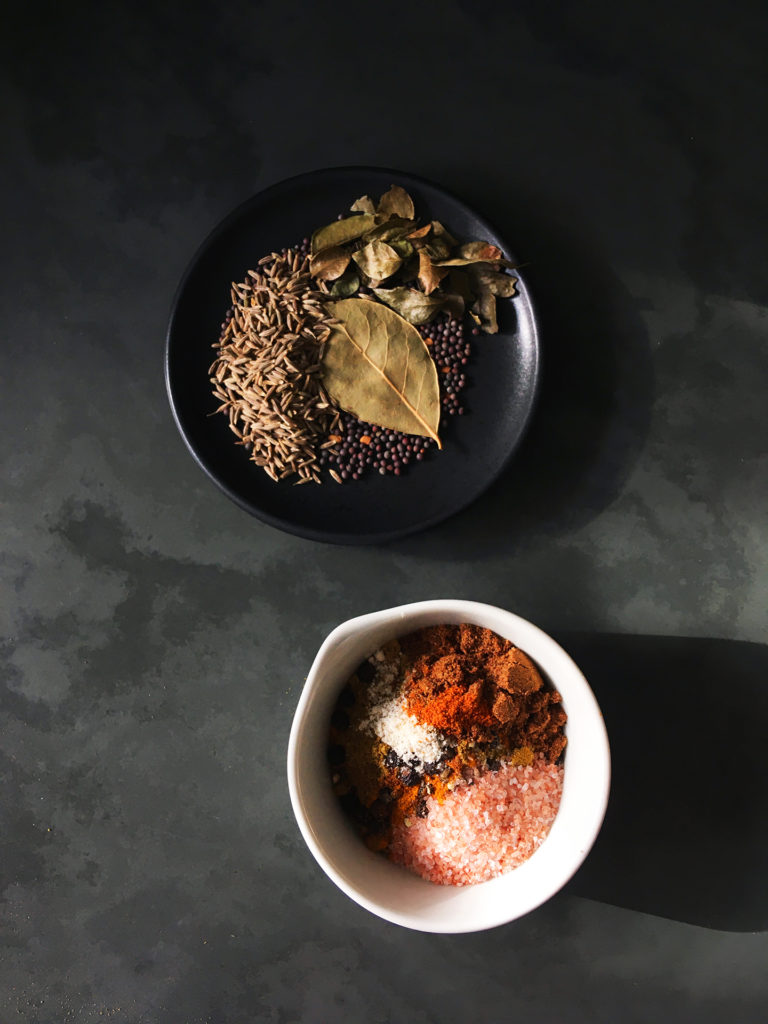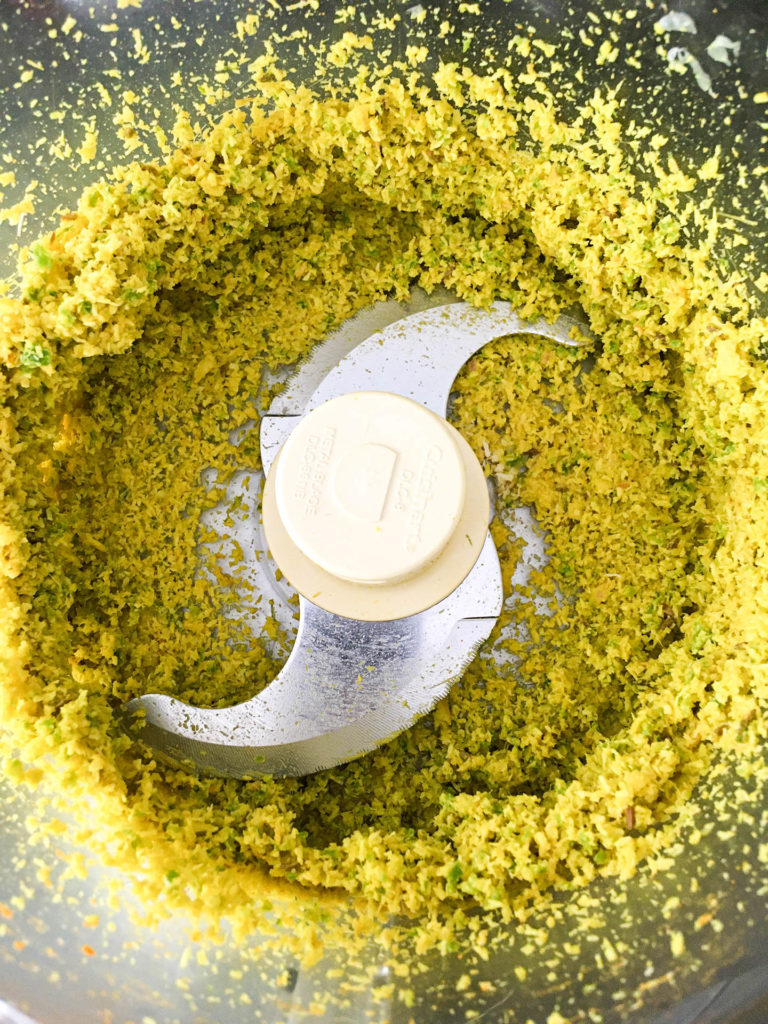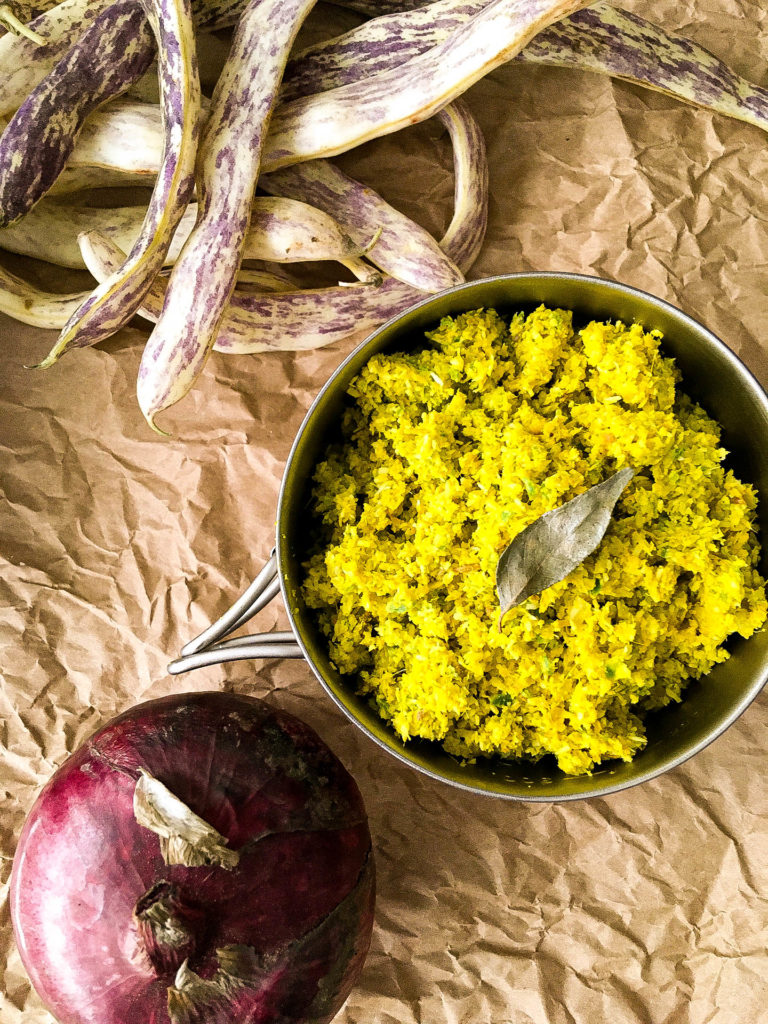Oh, hi. Meet your new best friend: ashwagandha lentil curry.
Full of warming spices, cozy, incredibly delicious, and packed with deeply nourishing anti-inflammatory ingredients, this golden curry is a total cold weather cooking staple that typically takes less than 30 minutes to make.
The pasture raised, grass-fed beef bone broth will help you become superhuman with its rich store of highly bioavailable vitamins, minerals, gelatin, collagen, and amino acids with its gut-healing, immune-boosting benefits.
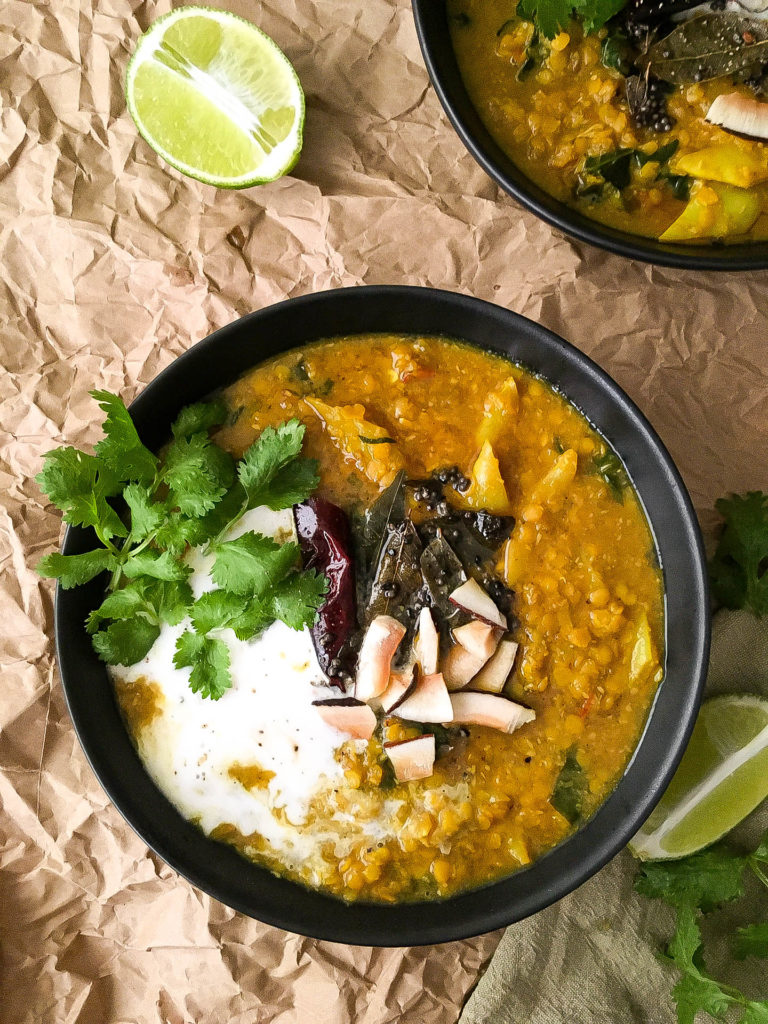
Ashwa-what?!
Ashwagandha: stress-buster for a superhuman existence
Adaptogens are all the rage these days despite having been part of traditional medicine for thousands of years. Ashwagandha, also known as Indian ginseng, is just one of many, and is possibly the most common kind these days (at least on the Internet). It’s an Ayurvedic rasayana, treasured for over six thousand years for its ability to invigorate and revitalize. In case you weren’t on this wave, adaptogens are a special class of tonic herbs (natural, nutritional “supplements”) that can help your body, mind and spirit adapt more easily under stress, promoting stamina, strength, resilience, and emotional and physical stress relief by down-regulating the body’s stress response, calming the mind and supporting healthy aging. It’s magic. They do not change the body, but rather subtly work with it to allow profound, balancing effects to unfold over time in a multidirectional and multidimensional way, helping to maintain homeostasis. And what’s more, they’re generally as safe to use as regular food.
Let’s face it: it is SO easy to be stressed out these days, but these herbs have become increasingly popular for good reason, especially if you live a Westernized lifestyle. They are fantastic tools that can help your body restore homeostasis, add an energetic spring to your step, and help you tread more lightly, playfully and equanimously in this lifetime, empowering us to be more committed with our contributions to the earth and those around us. The supplement industry is largely unregulated and can be pretty shady, so you’ll want to make sure you find herbs of TOP quality: ideally wildcrafted, organic, and di tao sourced if possible.

Ashwagandha (roughly known as ‘the strength of a stallion’ in Sanskrit) is an adaptogenic herb that I enjoy using from time to time, and this dal/lentil curry recipe takes great advantage of it. Traditionally it’s been used to strengthen the immune system after illness, and is probably a wise, preventative herb to take these days while living in the industrialized world. There have been over 200 scientific studies revealing its benefits. It’s got thyroid-modulating, neuroprotective, anti-tumor, anti-anxiety, antidepressant, and anti-inflammatory properties, to name just a few. Although it’s generally recognized as safe for regular use with no or minimal adverse reactions, I encourage you to seek the guidance of your primary health practitioner before integrating it into your life if you have specific requirements or concerns. In my case, I simply just read about it and right away, I intuitively knew it was for me at the time.
I’ve been using Ashwagandha in my meals and drinks on and off for a few years now. After taking small amounts regularly over the long-term, I’ve noticed subtle but powerful effects such as a profound increase in mental and physical resilience in the face of constant stresses that would probably incapacitate the average joe or the past version of me (hello, craving climbing a mountain during a global pandemic). I tend not to dwell on minutiae and overthink things as much as I used to. My life feels more easy to handle and a lot more equanimous in the hard times.
Generally, you can start and stop taking it whenever you feel like it—there really aren’t any rules set in stone, but it is recommended to use a little bit over a long period of time to experience its effects (about 1/4-1 tsp daily). Many people love sneaking it into their cooking, as high quality ashwagandha has a rather distinct taste. The kick of the tamarind along with the potent spices in this curry go along with it nicely and I barely notice its taste.
I also use ashwagandha quite randomly in my other home cooked meals, or added to herbal drinks, soups, smoothies, and even in baking recipes – usually about a teaspoon will suffice. The possibilities are endless.
Not only does this curry boast plenty of healing benefits, but it’s also free from the usual inflammatory industrial seed oils found in the average take-out or restaurant curry. This recipe is the real deal—at least in my kitchen—so you’ll also be making your own easy curry paste! Let’s dive in.
Special ingredient for the yellow curry paste:
- Asafoetida, aka. hing – find it here or here. This is a powdered resin that is strong and bitter, so a little goes a loooong way. It really adds an extra savoury dimension to curries in general. Hing is a resin obtained from the Ferula Assa Foetida plant’s roots by making small cuts. The juice comes out from the roots, which solidifies and converts into Hing resin. It’s absolutely packed with a multitude of health benefits!
Special ingredient for the dal (lentil curry):
- Ashwagandha – optional, but highly recommended. The high quality, wildcrafted stuff imparts quite a strong flavour but it’s hardly noticeable when such a small amount is combined with the other flavours in this curry. Find Organic Traditions organic ashwagandha here. Or find Sun Potion wildcrafted ashwagandha here (the BEST, imo)
Tips to cook this curry:
- Soak your lentils beforehand! I’m serious. If you want to get the most out of your lentils by neutralizing their antinutrients, simply soak the desired amount of dry lentils, submerged in a bowl of filtered water on the counter for approximately 12-24 hours. Then when you’re ready to cook with them, simply drain and rinse one more time before using. Soaking and sprouting was a common ancestral practice that’s experiencing a resurgence in popularity these days, and for good reason: it vastly improves the digestibility and nutrient bioavailability of lentils, pulses, and beans in general.
- Temper (toast) your spice toppings separately to add in last: The key to a delicious curry is through the contrast of a toasty, crunchy, tempered garnish. Here I used one dried Kashmiri chili, 1 tsp mustard seeds, 1 tsp fenugreek, and 5-10 dried curry leaves in high smoke point virgin coconut oil. You can also use any of your favourite whole or ground spices. Tempering, or tadka, is a traditional method used to extract the full flavour and nutrition out of the spices, typically heated in a healthy, high quality cooking fat, then added to a dish. When you’re tempering the spices, keep a close eye on it as the mixture burns quickly! Ideal high smoke point cooking fats include: virgin coconut oil, grass fed ghee, or grass fed tallow.
- Sourcing high quality bones for broth is imperative. Bones are not only high in minerals, but also tend to store heavy metals, so opt for ethically pasture raised, organic, and grass-fed and finished for optimal nutritional value. The highest quality bones will still be incredibly cheap. Ask your butcher or farmer. If you don’t have them on hand yet, just use filtered water or homemade vegetable stock.
- Blend your curry paste using a high speed blender or food processor fitted with the “S” blade. Stop intermittently to open the top and scrape down the sides with a spoon or silicone spatula. See below: you want to get the flyaway paste from the edges back into a compact clump for a quicker, more thorough blending job.
Along with the tempered spices, you can serve the lentil curry with pretty much anything you have on hand, from rice to coconut kefir yogurt, fresh cilantro, toasted coconut, diced avocado, or your favourite dukkah blend.
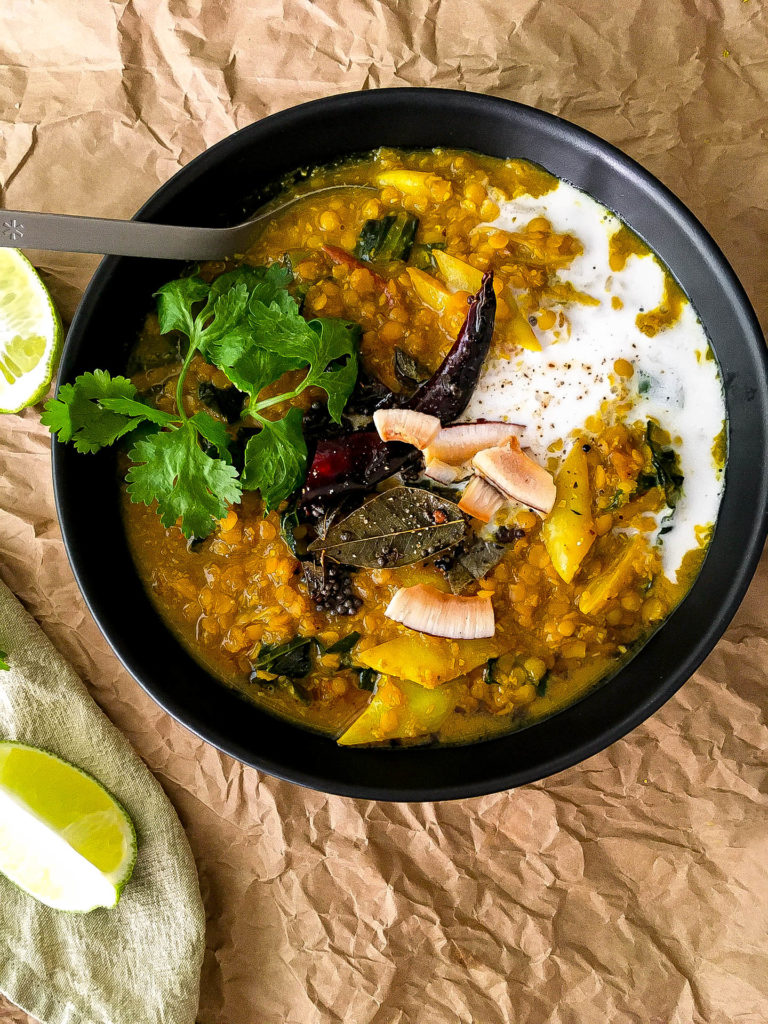
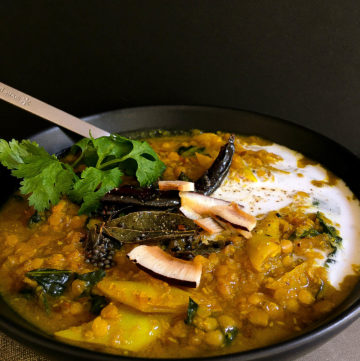
GOLDEN ADAPTOGENIC ASHWAGANDHA DAL (LENTIL CURRY) WITH TEMPERED SPICES IN GRASS-FED BEEF BONE BROTH
Ingredients
Yellow curry paste ingredients
- 1 organic lime juice + zest
- 1 inch knob of organic ginger
- 3 cloves organic garlic
- 1 small organic chili red or green, seeds removed
- 1 tsp organic ground cumin
- 1 tsp organic ground coriander
- 1 tbsp organic ground turmeric
- 1 tiny pinch organic/wildcrafted asafoetida (hing)
- 6 organic curry leaves
- 1 stick organic lemongrass white part only, about 5 in (12 cm) long
- 1/2 cup unsweetened shredded organic coconut
- 1/2 cup filtered water to thin it out
- sea salt and organic black pepper to taste
Dal (lentil curry) ingredients
- 2 tsp organic coconut oil virgin
- 1 organic medium onion, small dice
- organic curry paste (see above)
- 2 tsp wildcrafted ashwagandha
- 1 tsp organic tamari or organic coconut aminos
- 1 tsp organic maple syrup
- 1 tsp organic tamarind puree
- 1 medium organic tomato, chopped
- 1/2 cup organic green or other string beans, chopped in half
- 3/4 cup organic red lentils (masoor dal)
- 3-4 cups pasture raised, grass fed beef bone broth or liquid of your choice
- 1 tsp organic miso paste
- 2 stalks organic kale, chopped
- 1/3 cup organic coconut butter or coconut yogurt/kefir
- sea salt and organic black pepper to taste
- fresh chopped organic cilantro, freshly squeezed organic lemon juice, to serve
Tempering spices
- 1 tbsp organic coconut oil virgin
- 1 organic Kashmiri or other chili dried
- 1 tsp organic mustard seeds
- 1 tsp organic fenugreek seeds
- 6 organic curry leaves dried or fresh
Instructions
- First, make the curry paste. Place all the curry ingredients into a food processor: lime, ginger, garlic, chili, cumin, curry leaves, lemongrass, shredded coconut, sea salt, and black pepper. Add 1/2 cup of water to thin it out. Blend the mixture for a few minutes until you get a paste-like consistency, stopping every so often to scrape down the sides. Add a few more splashes of water if needed to get your desired consistency. Transfer the finished curry paste to a small bowl, and set aside.
- Make the dal (lentil curry). Heat the coconut oil in a large, heavy-bottomed pot over medium heat. Add the onions and sauté until soft and translucent, about 4 minutes.
- Add in all of the curry paste and continue to stir to evenly coat the onions with it. Stir until the spices are fragrant, about 30 seconds.
- Add the ashwagandha, tamari, maple syrup, tamarind, tomato, green beans and red lentils, and stir to coat them evenly with the oil and spices. Scrape any browned bits from the bottom of the pot. Season the mixture with salt and pepper. Pour in the bone broth, and give it a few more stirs to combine.
- Cover the pot with a lid and bring to a boil. Lower the heat to a simmer and and cook the stew, covered for about 30 minutes or until the lentils are cooked through.
- Meanwhile, temper your spice toppings. In a small sauté pan over medium-high heat, heat up the coconut oil. Lower the heat to medium-low once it starts shimmering. Add the Kashmiri chili, mustard seeds, fenugreek seeds, and curry leaves. Let them sit in the hot oil for about a minute, keeping a close eye on them to ensure they don't burn. Once the seeds are fragrant and popping, remove from heat and immediately set the pan aside to avoid burning the spices.
- By now, your dal should be simmering and considerably cooled down. Remove the pot from heat. Whisk the dal vigorously to encourage further breaking down of the lentils. Add in the miso paste, coconut butter and chopped kale, and stir to combine until the kale starts to wilt from the residual cooking heat.
- Gently spoon the tempered spices and oil on top of the dal. You can lightly stir it in, if you like. You can also portion out the dal into serving bowls and then garnish the tempered spices on top, if you like. Garnish the dal with fresh cilantro. Serve it hot with lemon wedges and your favourite toppings.
Notes
- Make sure to add in the miso paste once the dal has considerably cooled down. Too hot and you’ll kill the beneficial enzymes in the miso.
- You don’t need a lot of oil for spice tempering: one or two tablespoons is plenty. Just make sure not to temper them for too long as they burn quickly. Ideally, use a high smoke point oil, such as coconut oil, grass-fed ghee, or organic tallow.
- The key to proper spice tempering is temperature control. Burnt spices will ruin your entire dish! You’ll know when they’re ready once the seeds start popping or the spices have changed colour. It should only take a few seconds.
- Don’t temper fresh herbs—use them directly as a garnish instead.
- Soak your lentils beforehand! I’m serious. If you want to get the most out of your lentils, simply soak the desired amount of dry lentils, submerged in a bowl of filtered water on the counter for approximately 12-24 hours. Then when you’re ready to cook with them, simply drain and rinse one more time before using. Soaking and sprouting was a common ancestral practice that vastly improves the digestibility and nutrient bioavailability of lentils, pulses, and beans in general.

